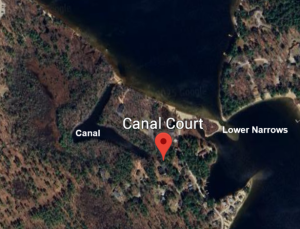In the 1970s, a “canal” type area was dredged at the south end of the middle lake, between the lower narrows and the boat launch, for a development that was never constructed. There is a narrow, very shallow passage, from the lake to this “canal” area. The “canal” is now loaded with milfoil.
The Maine DEP Division of Environmental Assessments Invasive Aquatic Species Program (IASP) has identified that a herbicidal treatment is the best means to eradicate the milfoil in this area. Because of the limited access, and the shallow very murky water, the conventional removal method used by the LSLA, with a diver and a suction hose, isn’t feasible. The DEP IASP requires a permit from the DEP Division of Water Quality Management for this work.
A public hearing, via a virtual Zoom meeting, will be held on Monday, July 28 at 6:00 PM, info below. Numerous people have asked where this herbicidal treatment has been previously used in Maine. The DEP IASP has assured us they will provide that information available at the public hearing.
We hope you will be able to attend the public hearing.
Sincerely,
The LSLA Board
———————————
NOTICE from The Maine Department of Environmental Protection, Division of Environmental Assessment’s Invasive Aquatic Species Program
MAINE DEPARTMENT OF ENVIRONMENTAL PROTECTION TO FILE NOTICE OF INTENT UNDER GENERAL PERMIT FOR APPLICATION OF AQUATIC HERBICIDES FOR THE CONTROL OF INVASIVE AQUATIC PLANTS
The Maine Department of Environmental Protection, Division of Environmental Assessment’s Invasive Aquatic Species Program (IASP), intends to file a Notice of Intent (NOI) with the Maine Department of Environmental Protection Division of Water Quality Management for herbicide treatment a portion of Little Sebago Lake to control the invasive aquatic plant hybrid water-milfoil (Myriophyllum heterophyllum x Myriophyllum laxum). The application is for a permit to discharge the aquatic herbicide Procellacor EC (active ingredient florpyrauxifen-benzyl) via subsurface injection through perforated hose from a surface watercraft into a portion of Little Sebago Lake.
The area proposed for treatment in 2025 or 2026 is a 3.7-acre cove just north of the Lower Narrows and near Canal Court.
The treatment goal is to significantly diminish the hybrid water-milfoil in this cove of Little Sebago Lake to reduce risk of spread and allow future management with non-chemical control methods. The treatment is part of a five-year management plan.
The IASP will hold a virtual public information meeting regarding this proposed herbicide treatment on Monday, July 28, at 6 p.m. The meeting will be on Zoom and will be recorded for subsequent viewing.
The link to the meeting is:
- https://mainestate.zoom.us/j/83010503018?pwd=aUejsWayCvgb5kU2TFHkmIzB8m819D.1
- Meeting ID: 830 1050 3018
- Passcode: 42841723
Please contact John McPhedran at john.mcphedran@maine.gov or 207.215.9863 if you have technical problems.
Upon treatment, the IASP will post these advisories for the area treated:
- Do not use lake water for hydroponic, greenhouse or nursery irrigation before contacting the IASP to confirm the herbicide has dissipated
- Do not use lake water for any residential or non-agricultural irrigation (such as shoreline property use for irrigation of residential landscape plants and homeowner gardens, golf course irrigation, and non-residential property irrigation around business or industrial properties) for 3 days following treatment.
- There is no swimming restriction for florpyrauxifen-benzyl but the IASP advises residents not to swim within treated areas on the day of treatment as an added safety measure.
The NOI will be submitted before or around August 1, 2025 and will be available via email along with dates of NOI submission, NOI approval and herbicide treatment. More information is available from the DEP IASP Coordinator, Maine DEP, State House Station 17, Augusta, ME 04333 (milfoil@maine.gov; 207- 215-9863).
